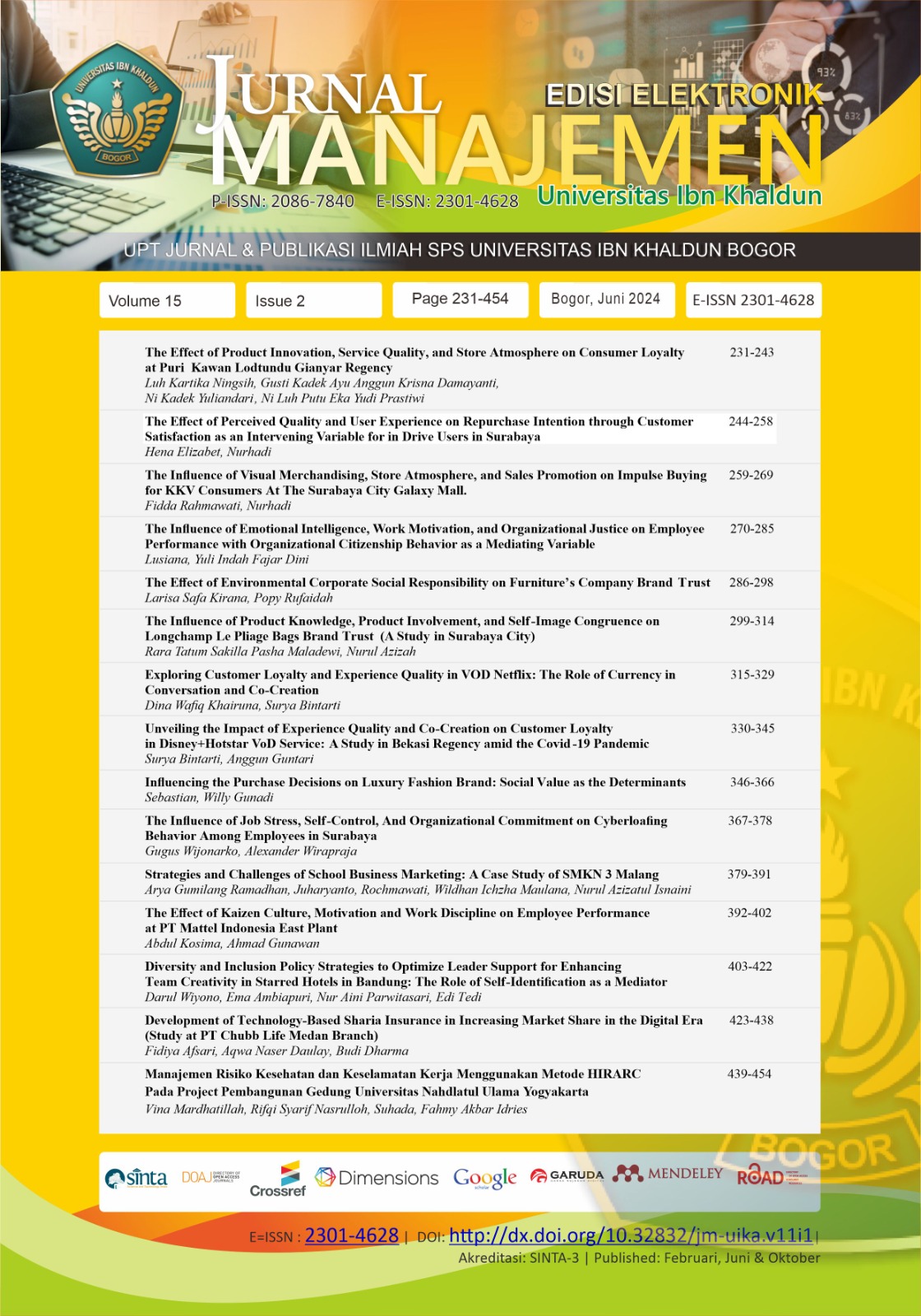The Influence of Product Knowledge, Product Involvement, and Self-Image Congruence on Longchamp Le Pliage Bags Brand Trust (A Study in Surabaya City)
DOI:
https://doi.org/10.32832/jm-uika.v15i2.16459Kata Kunci:
product knowledge, product involvement, self-image congruence, brand trustAbstrak
This research contributes to a deeper understanding of consumer behavior in the luxury goods market, providing valuable insights for businesses aiming to strengthen brand trust and expand their market presence of Longchamp Le Pliage bags in Surabaya City. Employing online questionnaires disseminated among Longchamp Le Pliage bag users in Surabaya, data was meticulously gathered from a sample comprising 144 respondents. Utilizing multiple linear regression analysis, the research unveils that product knowledge emerges as the paramount determinant of brand trust, closely followed by self-image congruence and product involvement. These findings underscore the critical importance of these variables in shaping consumer perceptions of the Longchamp brand.. For enterprises aspiring to fortify consumer trust in their brands, accentuated emphasis on augmenting product knowledge, honing product development strategies, and nurturing self-image congruence emerges as imperative. Furthermore, exploring further factors influencing brand trust is suggested for future research endeavors, aiming to provide a more intricate understanding of consumer behavior within the luxury goods market landscape.
Referensi
Asprilia, M. T., & Hami, A. E. (2021). Persepsi Nilai Mewah pada Konsumen Tas Branded: Kajian Nilai Budaya di Indonesia. Jurnal Ilmu Keluarga Dan Konsumen, 14(1), 76–87. https://doi.org/10.24156/jikk.2021.14.1.76
Arief, M., Suyadi, I., & Sunarti. (2017). Pengaruh Kepercayaan Merek dan Komitmen Merek Terhadap Loyalitas Merek (Survei pada Warga Kelurahan Penanggungan Konsumen Produk Aqua di Kota Malang). Jurnal Administrasi Bisnis (JAB)|Vol, 44(1), 144–153.
Chu Lo, C. K. Y., Burton, S., Lam, R., & Nesbit, P. (2021). Which Bag? Predicting Consumer Preferences for a Luxury Product With a Discrete Choice Experiment. Australasian Marketing Journal, 29(4), 329–340. https://doi.org/10.1177/1839334921999506
Dewi, S. E. K., & Hendrastomo, G. (2018). Perilaku belanja produk tas tiruan bermerek eksklusif sebagai bentuk representasi identitas diri di kalangan mahasiswa universitas negeri Yogyakarta. Jurnal Pendidikan Sosiologi, 1(1), 1–12.
Falsafani, M. (2020). Pengaruh Self-Image Congruence Terhadap Brand Association, Perceived Quality, Brand Trust, Dan Brand Loyalty Pada Milenial Di Indonesia. Jurnal Manajemen Dan Bisnis Indonesia, 6(1), 1–11. https://doi.org/10.32528/jmbi.v6i1.3529
Hernanta, M. F. P. (2017). the Role of Brand Image, Product Involvement, and Knowledge in Explaining Consumer Purchase Behavior of Counterfeit Branded Products of Converse. Research Journal, 1–18. https://dspace.uii.ac.id/bitstream/handle/123456789/7250/08 naskah punlikasi.pdf?sequence=12&isAllowed=y
Kautish, P., Khare, A., & Sharma, R. (2020). Influence of values, brand consciousness and behavioral intentions in predicting luxury fashion consumption. Journal of Product and Brand Management, 30(4), 513–531. https://doi.org/10.1108/JPBM-08-2019-2535
Kusnadi, A. H. (2020). PENGARUH PRODUCT INVOLVEMENT DAN WORD OF MOUTH ( Studi Kasus Konsumen di Kota Medan ). SKRIPSI Memperol.
Lo, V. P. (2019). Pengaruh product quality, brand image, dan, product knowledge terhadap trust dan repurchase intention pada konsumen apple watch.
Nadhifah, S., & Batu, R. L. (2021). Pengaruh Self Image Congruence Terhadap Keputusan Pembelian Dimediasi Oleh Brand Trust Pada Maskapai Penerbangan Air Asia. Jurnal Ilmu Manajemen, 9(4), 1477–1486. https://doi.org/10.26740/jim.v9n4.p1477-1486
Padmasari, D., & Widyastuti, W. (2022). Influence of Fashion Involvement, Shopping Lifestyle, Sales Promotion on Impulse Buying on Users of Shopee. Jurnal Ilmu Manajemen, 10(1), 123–135. https://doi.org/10.26740/jim.v10n1.p123-135
Prasetya, H., & Azizah, N. (2022). APAKAH PERSEPSI KONSUMEN MENGENAI RISIKO DAN KEPERCAYAAN BERPENGARUH TERHADAP KEPUTUSAN ? 5(2), 2108–2116.
Resmawa, I. N. (2022). Pengaruh Brand Image Dan Product Knowledge Terhadap Purchase Intention Dengan Green Price Sebagai Moderating Variabel Pada Produk the Body Shop. Dinamika Ekonomi - Jurnal Ekonomi Dan Bisnis, 15(1), 69–88. https://doi.org/10.53651/jdeb.v15i1.365
Setiawati, S. (2023, 8 September). Crazy Rich Royal ASEAN Akan Jadi Surga Belanja Barang Mewah. Diakses dari https://www.cnbcindonesia.com/research/20230908121444-128-470711/crazy-rich-royal-asean-akan-jadi-surga-belanja-barang-mewah
Yulinda, A. T., Rahmawati, R., & Sahputra, H. (2022). Pengaruh Shopping Lifestyle Dan Fashion Involvement Terhadap Impulse Buying (Studi Kasus Pada Konsumen Toko Mantan Karyawan Kota Bengkulu). EKOMBIS REVIEW: Jurnal Ilmiah Ekonomi Dan Bisnis, 10(2), 1315–1326. https://doi.org/10.37676/ekombis.v10i2.2456
Widanti, A., & Alfansi, L. (2019). Pengaruh Keterlibatan Fesyen terhadap Kepercayaan Merek dengan Mediasi Nilai Hedonis dan Nilai Utilitarian pada Konsumen Gawai, Tablet dan Laptop. Jbe, 26(2), 166–178. https://www.unisbank.ac.id/ojs;
Unduhan
Diterbitkan
Cara Mengutip
Terbitan
Bagian
Lisensi
Hak Cipta (c) 2024 Jurnal Manajemen (Edisi Elektronik)

Artikel ini berlisensi Creative Commons Attribution-NonCommercial 4.0 International License.
Authors who publish with this journal agree to the following terms:
- Authors retain copyright and grant the journal right of first publication with the work simultaneously licensed under a Creative Commons Attribution-NonCommercial-ShareAlike 4.0 International License that allows others to share the work with an acknowledgement of the work's authorship and initial publication in this journal.
- Authors can enter into separate, additional contractual arrangements for the non-exclusive distribution of the journal's published version of the work (e.g., post it to an institutional repository or publish it in a book), with an acknowledgement of its initial publication in this journal.
- Authors are permitted and encouraged to post their work online (e.g., in institutional repositories or on their website) prior to and during the submission process, as it can lead to productive exchanges, as well as earlier and greater citation of published work (See The Effect of Open Access).











